Toyota Grand Highlander (AS10): Smart key system
The following operations can be performed simply by carrying the electronic key on your person, for example in your pocket. The driver should always carry the electronic key.
- Locks and unlocks the doors
- Locks and unlocks the back door
- Starts and stops the engine
■Antenna location
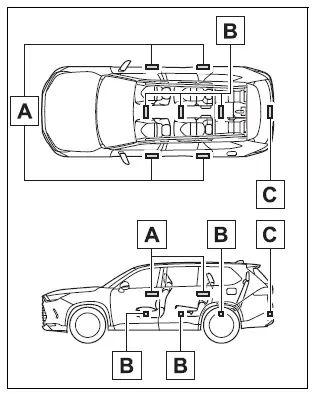
- Antennas outside the cabin
- Antennas inside the cabin
- Antenna outside the luggage compartment
■Effective range (areas within which the electronic key is detected)
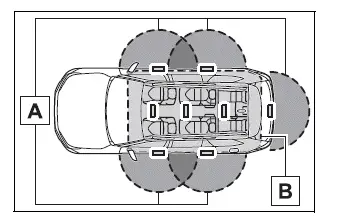
- When locking or unlocking the doors
The system can be operated when the electronic key is within about 2.3 ft. (0.7 m) of an outside door handle.
(Only the doors detecting the key can be operated.)
- When starting the engine or changing engine switch modes
The system can be operated when the electronic key is inside the vehicle.
■Alarms and warning messages
An alarm sounds and warning messages are displayed on the multi-information display to protect against unexpected accidents or theft of the vehicle resulting from erroneous operation. When a warning message is displayed, take appropriate measures based on the displayed message. When only an alarm sounds, circumstances and correction procedures are as follows.
- When an exterior alarm sounds once for 5 seconds
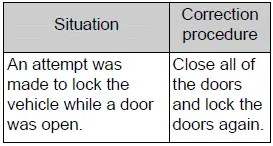
- When an interior alarm sounds continuously
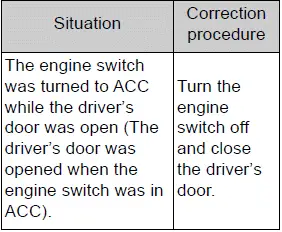
■If "Key Detected in Vehicle" is shown on the multi-information display
An attempt was made to lock the doors using the smart key system while the electronic key was still inside the vehicle. Retrieve the electronic key from the vehicle and lock the doors again.
■Battery-saving function
The battery-saving function will be activated in order to prevent the electronic key battery and the battery from being discharged while the vehicle is not in operation for a long time.
- In the following situations, the
smart key system may take some
time to unlock the doors. Also the
illuminated entry system may not
operate properly.
- The electronic key has been left in
an area of approximately 11 ft.
(3.5 m) of the outside of the vehicle for 40 seconds or longer.
- The smart key system has not been used for 5 days or longer.
- The electronic key has been left in
an area of approximately 11 ft.
- If the smart key system has not
been used for 14 days or longer,
the doors cannot be unlocked at
any doors except the driver's door.
In this case, take hold of the driver's door handle, or use the wireless remote control or the mechanical key, to unlock the doors.
■Turning an electronic key to battery-saving mode
When battery-saving mode is set, battery depletion is minimized by stopping the electronic key from receiving radio waves.
Press  twice while pressing and
holding
twice while pressing and
holding  . Confirm that the
electronic
key indicator flashes 4 times.
. Confirm that the
electronic
key indicator flashes 4 times.
While the battery-saving mode is set, the smart key system cannot be used. To cancel the function, press any of the electronic key buttons.
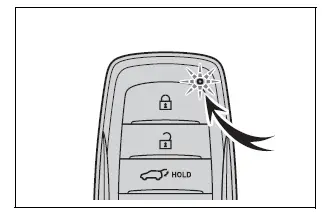
■When electronic key function stops
If the position of the electronic key has not changed for a certain amount of time such as when the electronic key is left some where, the function of the electronic key stops to reduce depletion of the battery.
■Conditions affecting operation
The smart key system, wireless remote control and engine immobilizer system use weak radio waves.
In the following situations, the communication between the electronic key and the vehicle may be affected, preventing the smart key system, wireless remote control and engine immobilizer system from operating properly.
- When the electronic key battery is depleted
- Near a TV tower, electric power plant, gas station, radio station, large display, airport or other facility that generates strong radio waves or electrical noise
- When the electronic key is in contact with, or is covered by the following metallic objects
- Cards to which aluminum foil is attached
- Metallic wallets or bags
- Coins
- Hand warmers made of metal
- Media such as CDs and DVDs
- When other wireless keys (that emit radio waves) are being used nearby
- When carrying the electronic key together with the following devices that emit radio waves
- Portable radio, cellular phone, cordless phone or other wireless communication devices
- Another vehicle's electronic key, another electronic key of your vehicle, or a wireless key that emits radio waves
- Personal computers or personal digital assistants (PDAs)
- Digital audio players
- Portable game systems
- If window tint with a metallic content or metallic objects are attached to the rear window
- When the electronic key is placed near a battery charger or electronic devices
- When the vehicle is parked in a pay parking spot where radio waves are emitted
If the doors cannot be locked/unlocked using the smart key system, lock/unlock the doors by performing any of the following:
- Bring the electronic key close to either front door handle and operate the entry function.
- Operate the wireless remote control.
If the doors cannot be locked/unlocked using the above methods, use the mechanical key.
■Note for the entry function
- Even when the electronic key is
within the effective range (detection
areas), the system may not
operate properly in the following
cases:
- The electronic key is too close to the window or outside door handle, near the ground, or in a high place when the doors are locked or unlocked.
- The electronic key is on the instrument panel, luggage compartment, floor, or in the door pockets or glove box when the engine is started or engine switch modes are changed.
- Do not leave the electronic key on top of the instrument panel or near the door pockets when exiting the vehicle. Depending on the radio wave reception conditions, it may be detected by the antenna outside the cabin and the door will become lockable from the outside, possibly trapping the electronic key inside the vehicle.
- As long as the electronic key is within the effective range, the doors may be locked or unlocked by anyone. However, only the doors detecting the electronic key can be used to unlock the vehicle.
- Even if the electronic key is not inside the vehicle, it may be possible to start the engine if the electronic key is near the window.
- The doors may unlock if a large
amount of water splashes on the
door handle, such as in the rain or
in a car wash when the electronic
key is within the effective range.
(The door will automatically be locked after approximately 60 seconds if the doors are not opened and closed.)
- If the wireless remote control is used to lock the doors when the electronic key is near the vehicle, there is a possibility that the door may not be unlocked by the entry function. (Use the wireless remote control to unlock the doors.)
- Touching the door lock sensor while wearing gloves may delay or prevent lock operation. Remove the gloves and touch the lock sensor again.
- When the lock operation is performed using the lock sensor, recognition signals will be shown up to two consecutive times. After this, no recognition signals will be given.
- If the door handle becomes wet
while the electronic key is within
the effective range, the door may
lock and unlock repeatedly. In that
case, follow the following correction
procedures to wash the vehicle:
- Place the electronic key in a location 6 ft. (2 m) or more away from the vehicle. (Take care to ensure that the key is not stolen.)
- Set the electronic key to battery- saving mode to disable the smart key system.
- If the electronic key is inside the
vehicle and a door handle
becomes wet during a car wash, a
message may be shown on the
multi-information display and a
buzzer will sound outside the vehicle.
To turn off the alarm, lock all the doors.
- The lock sensor may not work properly if it comes into contact with ice, snow, mud, etc. Clean the lock sensor and attempt to operate it again.
- A sudden approach to the effective range or door handle may prevent the doors from being unlocked. In this case, return the door handle to the original position and check that the doors unlock before pulling the door handle again.
- If there is another electronic key in the detection area, it may take slightly longer to unlock the doors after the door handle is gripped.
■When the vehicle is not driven for extended periods
- To prevent theft of the vehicle, do not leave the electronic key within 6 ft. (2 m) of the vehicle.
- The smart key system can be deactivated in advance.
- Setting the electronic key to battery- saving mode helps to reduce key battery depletion.
■To operate the system properly
Make sure to carry the electronic key when operating the system. Do not get the electronic key too close to the vehicle when operating the system from the outside of the vehicle.
Depending on the position and holding condition of the electronic key, the key may not be detected correctly and the system may not operate properly. (The alarm may go off accidentally, or the door lock prevention may not operate.)
■If the smart key system does not operate properly
- If the doors cannot be locked or
unlocked and the back door cannot
be opened, perform the following.
- Bring the electronic key close to the door handle and perform a lock or unlock operation.
- Bring the electronic key close to the button on the back door and press the button.
- Use the wireless remote control.
If the doors cannot be locked or unlocked by perform the above, use the mechanical key. However, if the mechanical key is used while the alarm system is set, the warning will sound.
- If the engine cannot be started.
■Customization
Some functions can be customized.
■If the smart key system has been deactivated in a customized setting
- Locking and unlocking the doors: Use the wireless remote control or mechanical key.
- Starting the engine and changing engine switch modes.
- Stopping the engine.
WARNING
■Caution regarding interference with electronic devices
- People with implantable cardiac pacemakers, cardiac resynchronization therapy- pacemakers or implantable cardioverter defibrillators should keep away from the smart key system antennas. The radio waves may affect the operation of such devices. If necessary, the entry function can be disabled. Ask your Toyota dealer for details, such as the frequency of radio waves and timing of the emitted radio waves. Then, consult your doctor to see if you should disable the entry function.
- Users of any electrical medical
device other than implantable
cardiac pacemakers, cardiac
resynchronization therapy-
pacemakers or implantable
cardioverter defibrillators should
consult the manufacturer of the
device for information about its
operation under the influence of
radio waves.
Radio waves could have unexpected effects on the operation of such medical devices.
Ask your Toyota dealer for details on disabling the entry function.
Similar pages:
Correct use of the seat
belts
Extend the shoulder belt so
that it comes fully over the
shoulder, but does not come
into contact with the neck or
slide off the shoulder.
Position the lap belt as low as possible over the hips.
Adjust the position of the
seatback. Sit up straight and
well back in the seat.
Do not twist ...
RCTA (Rear Cross Traffic Alert)
function
The RCTA function uses the
BSM rear side radar sensors
installed behind the rear
bumper. This function is
intended to assist the driver
in checking areas that are
not easily visible when
backing up.
WARNING
■Cautions regarding the use of
the system
The driver is solely responsible for
safe driving ...


